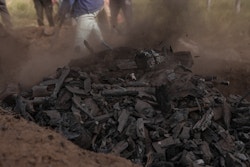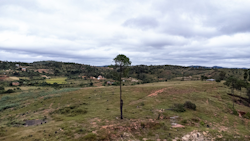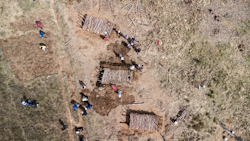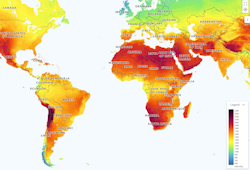Charcoal: when a renewable resource becomes unsustainable
Our energy expert, Beatrice Cordiano, tells us more about the role of biomass - and charcoal - in Madagascar, the consequences of an unsustainable management of this resource and the emerging solutions to safeguard forests.
The burning issue of charcoal
When we say Madagascar, we think biodiversity. There, landscapes are extremely diverse, spanning from the coastal plains to the central highlands, reaching altitudes between 800 and 2000 meters and covering about 3/4 of the country’s surface area. Thanks to this diversity, Madagascar is blessed with an extraordinary biological wealth: lemurs leaping through the treetops, chameleons perfectly blending in with their surroundings and rainforests that are home to a huge variety of endemic species. Yet, beneath this rich surface lies a pressing issue: deforestation. And one of the reasons of that is energy.
With 80% of the population living with less than 2 dollars per day, Madagascar is one of the poorest countries in the world and there, access to infrastructure is among the lowest in Sub-Sahara Africa and in the whole world: in 2020, approximately 33% of the population had access to electricity, against the Sub-Saharan average of 48%, leaving over 18 million people lacking access to power and having few option to meet their energy needs. There, the choice falls inevitably on a wide ready-available renewable resource: biomass.

Energy Observer in Madagascar
Charcoal, in between coal and wood
In this country - and in many others in Africa - biomass covers a big share of the primary energy consumption. Nothing surprising when electricity makes up just 2-3% of this mix. In fact, more than 85% of these needs are met by this resource, in the form of wood and charcoal, mainly used for heating and cooking.
While firewood is the preferred option in rural areas, charcoal is mainly used in cities. Charcoal is the fuel used in developing economies as well as the material for barbecues in developed nations. It is a solid fuel created through pyrolysis, a process of carbonisation where complex carbon substances - especially wood - are slowly heated in the absence of air and broken down into carbon and other chemicals. Charcoal undergoes a transformation before reaching our grills and stoves: the wood used to produce it, stacked in a specific manner to create a mound, is ignited, absorbs heat, dries, giving off moisture in the form of water vapour, then thermally decomposes. When the temperature reaches more than 400 °C the wood has essentially become charcoal, a “vegetal” coal that has taken some days to form instead of million years like the sedimentary rock which is fossil coal.

Ecological charcoal in Madagascar
Charcoal holds a significantly higher calorific density, or in other words a greater energy content, compared to its original wood source, reaching approximately 28 to 33 MJ/kg (just like coal), whereas dry wood typically contains around 18 MJ/kg. Nevertheless, this gain in energy density is done at the expense of losing over half of the wood’s available energy during pyrolysis. In fact, 100 kg of dry wood are needed to produce 25 kg of charcoal: an immense waste of wood. What is the reason of using charcoal instead of firewood then? It burns slower, cleaner - let’s not forget it is often used in households - it is easier to use, lighter and more compact meaning it is easier to transport and store, more readily available than gas or electricity and still cheaper than wood. Enough reasons to rely on this resource.
A green not-so-green energy mix
4/5 of the country’s energy mix is "renewable": finally a green one, dare we say! Not really. Indeed, burning biomass emits carbon dioxide, just like burning fossil fuels. However, the advantage of biomass as an energy source lies in the fact that the amount of CO2 released into the atmosphere during its combustion is almost equivalent to the one that trees have captured through photosynthesis while growing. In other words, these emissions are offset by the CO2 sequestration during the tree’s growth cycle. This dynamic can make biomass a potentially carbon-neutral energy alternative. Potentially, yes, when the resource is supplied sustainably. That is unfortunately not the case for Madagascar, where the charcoal industry has become one of the biggest engines of the country’s economy, yet it represents one of the greatest threats to its environment.

Witnessing deforestation in Madagascar
110 000 tonnes of charcoal are consumed every year in Antananarivo alone, assuming that an urban family consumes around 2 bags, namely around 60 to 70 kg, of charcoal per month. On the ground, it translates into the deforestation of 32 000 hectares of forest yearly. According to some estimates, in 2012, 402 000 tonnes of charcoal were consumed on the whole island leading to around 110,000 ha of decimated forest. The problem lies just partly in the number of trees cut down every year, the real issue is that the rate of deforestation is much higher than the natural reproduction potential of these forests, to the extent that Madagascar has lost almost 45% of its natural forests since the 1950s and that does not seem to slow down.
The charcoal business contributes - but it is not the only one, slash-and-burn agriculture does too - to rampant deforestation, exacerbating the detrimental impacts of climate change: air pollution, biodiversity loss, and soil erosion among others. Moreover, as if it wasn’t enough already, in addition to these grave consequences, the price of charcoal is experiencing a surge. Less trees means less charcoal and less charcoal means higher prices as producers strive to maintain profitability. A complex ecological, economic, and social pressure to face for a low-income country.
Towards a more sustainable charcoal industry
Today, the need to preserve renewable natural resources is particularly pressing given the scale of charcoal production in Madagascar and in many other countries in Africa. The most straight-forward solution to mitigate the far-reaching impacts of its production is restoring forests, and that is what Bôndy - one of the many local organisations fighting against forest logging - does all over the island with its many tree nurseries. It is our responsibility to reforest, actively planting trees to compensate for those that have been cut down.

Energy Observer in Madagascar
But that’s not all, the efforts to combat deforestation and promote sustainability in the country’s biomass sector go beyond reforestation alone. Improved carbonisation techniques have been implemented to produce enhanced coal: a sort of carbonization 2.0 which allows to produce charcoal more efficiently, burning less wood thus sparing trees and, along with them, their stored carbon. A technique which takes 10-15 days compared to 5 days for traditional methods but produces a high-quality more energy-dense fuel.
On the utilisation side, energy-saving cooking equipment, locally known as “fatana mitsitsy”, have been introduced to slow down the combustion, reducing energy waste and therefore fuel consumption. These improved stoves combined with enhanced production techniques can save up to 50% on charcoal consumption.

PVOUT values in kWh/kWp/year
As we navigate the challenges of energy demand and environmental conservation and if we want biomass to be sustainable, carbon-neutral or even carbon-negative, we need to find the right compromise between meeting energy needs and preserving the delicate balance of nature. And to do so, we need to protect our forests, giving them the time to regrow, because more efficient production techniques and a more moderate use of this fuel will certainly help slow down deforestation but, alas, it will not be able to stop it.
